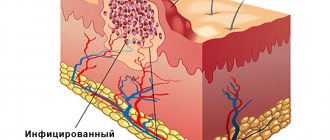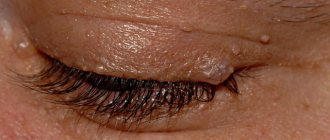Papillomas can spoil a person’s aesthetic appearance, as well as cause him painful and unpleasant sensations. Warts have a tendency to grow and transform into malignant tumors, so they must be removed. To ensure timely detection of any pathological abnormalities, papillomas should be constantly monitored. This is especially true for large warts and unusual shapes. When the first uncharacteristic changes appear (the size of the papilloma is more than 5 mm, unclear contours and uneven surface of the tumor, uneven color of the wart), you should consult a doctor to choose the most effective method for eliminating the pathological formation.
The use of external agents, taking anti-inflammatory, antibacterial and immunomodulating drugs does not guarantee one hundred percent removal of skin growths. Surgical treatment is considered the most effective method of combating papilloma. One of the effective methods for excision of pathological neoplasms is papilloma surgery.
Surgical removal of warts is a traditional way to combat papilloma, which is carried out using a scalpel. The essence of the operation is to make a bordering incision covering healthy surrounding tissues and superficial layers of the epidermis. Depending on the size, location and distribution of the papilloma, the incision can reach 0.5 cm. In this case, the wart is completely removed. After completion of the procedure, the postoperative wound is sutured with atraumatic suture material. The removed papilloma is sent for further histological examination, which will refute or confirm the malignancy of the neoplasm.
Indications and limitations for surgical excision of warts
Surgical removal can be carried out at the request of the patient or for medical reasons. These include:
- Suspicion or diagnosis of malignancy of the neoplasm;
- The presence of papillomas that have broken up into several parts;
- Pain when pressing on the papilloma;
- The presence of large and multiple warts.
Removing growths using a scalpel, like any surgical intervention, has a number of contraindications:
- Exacerbation of chronic diseases;
- The presence of an active herpes infection;
- Infectious diseases;
- Inflammatory processes in the body.
Surgical removal of papilloma can be carried out after neutralizing the causes and clinical manifestations of the pathological condition. Attempts to remove warts on your own can provoke the spread of infection and the development of an oncological process. Surgical removal of skin tumors should be performed exclusively in a specialized clinic by a professional doctor.
Causes of warts
The appearance of warts is caused by infection with papillomavirus or HPV.
Since the skin on the lips is quite thin, it is therefore easily permeable to viruses.
It should be noted that signs of infection with the human papillomavirus do not always occur.
The better the immune system, the less likely it is that symptoms of the disease will appear.
And yet, most of the world's population is infected with HPV.
The incubation period for the development of the disease can be several months or years.
As soon as the immune system fails, the first signs of infection appear.
Activation of the virus is accompanied by the formation of warts.
As a rule, growths appear on the area of the skin or mucous membrane where the pathogen entered the body.
Infection can occur both through sexual contact and through household contact.
Can the virus be transmitted by kissing on the lips?
The most common cases of infection are:
- intrauterine infection of the fetus if a pregnant woman is infected with papillomavirus
- shaking hands or kissing an infected person (if there are wounds or abrasions, the risk of infection increases)
- the use of personal items of an infected person (toothbrush, dishes, lipstick) is unlikely, since the pathogen is not stable in the environment
- sex accompanied by oral sex
- visiting common areas (swimming pool, sauna, shower)
People at risk are those who:
- patients with diabetes mellitus or other pathology of the endocrine system
- suffer from obesity and metabolic disorders
- taking antibiotics for a long time
- have chronic diseases
- suffer from increased sweating, especially on the feet, as this is where plantar warts often form
A malfunction of the immune system can occur for the following reasons:
- If there is a deficiency of essential substances in the body
- After suffering stress or physical exhaustion
- In case of hormone imbalance: during puberty, during pregnancy, with the onset of menopause, during treatment with hormonal drugs
- In case of chronic lack of sleep and overwork
- Due to a recent infectious disease
- If a person abuses smoking and alcoholic beverages
Preparing for papilloma removal
Before surgical excision of a wart, the patient undergoes a preliminary comprehensive examination, which includes a consultation with a dermatologist, a number of instrumental and laboratory tests. Carrying out a comprehensive diagnosis makes it possible to identify possible contraindications to surgical treatment of papillomas, assess the patient’s health status, and determine the location, number, size and distribution of skin tumors. Having studied the results of clinical studies, the doctor develops tactics to combat papilloma and refers the patient to an anesthesiologist who will select the most optimal dose and method of administering the anesthetic drug.
Excision of a wart does not require special preparation, other than a preliminary examination. The patient comes to the clinic on the appointed day, receives sterile clothing, consults with a doctor and is sent to the operating room for the procedure.
Pharmacy products for removing warts
You can buy medications at the pharmacy that will help you deal with warts at home.
Among them:
- Super clean . The product is an alkaline solution that has a chemical effect on the growth, causing cauterization.
- Cryopharma, Wartner . These agents cause cryodestruction of the wart; as a result of cold exposure, the neoplasm is frozen.
- Solcoderm . A drug containing acids that have a cauterizing and mummifying effect on pathological tissues.
- Immunomodulators – Viferon, Oxolinic ointment will help increase immunity and the body’s fight against the virus.
- Antiviral agents – Isoprinosine, Interferon.
The use of cauterizing agents on the lips and face is extremely undesirable; application of these agents to the oral mucosa is especially dangerous.
How to remove papilloma with a scalpel
The method of surgically combating papilloma can be carried out in two ways:
- Excision with cauterization (the papilloma is burned out using a special device);
- Wart surgery with suturing.
On average, the operation lasts 40-60 minutes. The duration of the intervention will depend on the condition and individual characteristics of the patient, as well as the spread and size of the skin tumor.
The fight against papilloma with a scalpel without suturing begins with treating the operated area with an antiseptic and using local anesthesia. After the anesthesia has begun to take effect, the doctor excises the wart at the level of the skin and cauterizes the wound with a special device. The wound is then treated with a local antibacterial drug and a sterile dressing is applied. After completing the procedure, the doctor provides the patient with recommendations for caring for the postoperative wound and sends the removed papilloma for histological analysis.
The fight against papilloma surgically with suturing is carried out in several stages:
- Treatment of the operating area with antiseptic drugs;
- Use of local anesthesia;
- Excision of the wart with partial capture of surrounding healthy tissue;
- Treatment of the wound with an antiseptic;
- Application of deep, self-absorbing or superficial sutures. The choice of a certain type of seams depends on the depth of growth growth;
- Treatment of the wound with an antibacterial drug;
- Applying a sterile bandage and plaster.
The removed papilloma is also sent for histological examination to confirm or refute the benignity of the neoplasm. The sutures are removed 10-12 days after the operation (this applies to superficial sutures).
To make a postoperative scar less noticeable, surgeons use modern silicone patches, which are glued to the scar and worn for 10-15 days. If the patient is not satisfied with the appearance of the postoperative area, plastic surgery may be performed.
Types of diseases
The structure of skin neoplasms can be completely different: they represent clusters of blood vessels, have different colors, sizes, and shapes. These can be yellow, dark brown and black formations. They can be flat, convex, absolutely smooth and, on the contrary, rough, covered with hairs, attached to the body by a stalk. Dermatologists distinguish the following types of moles:
Pigmented moles
Impaired skin production of melanin leads to the formation of:
- freckles (ephelides) mainly on open parts of the body, face, shoulders;
- vitiligo - white, sharply defined spots that appear when the secretion of skin pigment is impaired;
- nevi - epidermal-dermal formations, birthmarks and moles;
- chloasma – symmetrical brown spots located on the face, etc.
Vascular moles - angiomas
Red moles appear at any age - from birth to old age. To be more precise, angiomas are not moles. These are nodules that consist of overgrown vessels. For what reason they appear is unknown to modern medicine. But doctors confidently say that red formations of this type do not pose a danger to human health. Their removal is recommended solely for cosmetic purposes.
Papillomatous nevi
Papillomatous nevi are nipple-shaped growths of the epidermis. They are common benign epithelial neoplasms. Pappilomatous nevus differs from simple moles in its unpleasant appearance. They are removed for cosmetic purposes. They are not harmful to health.
Keratomas
Keratomas initially look like freckles. Over time, the spot begins to horny and peel off, turning into a dark brown or black plaque. The size of the keratoma usually varies from 10 to 20 mm. A “ripe” keratoma resembles a raisin pressed into the skin. Keratoma may be single. Sometimes the skin can be affected by several neoplasms. Most often, the disease occurs without symptoms, sometimes they self-amputate, i.e. disappear.
Warts
Warts are very common. They can have different shapes and sizes. They are conventionally divided into:
- dome-shaped - have a rough surface, dark gray color;
- plantar – thick warts, hard to the touch, localization – feet;
- pointed (condylomas) - beige-gray in color, localized in the groin, anus, vagina in women. There are cases of their degeneration into malignant formations.
- flat – growths with a flat top, flesh-colored, localized – arms, legs, face;
- thread-like - flesh-colored formations shaped like a nipple, localization - face, shoulders;
- periungual – uneven bumps that affect the growth of the nail plate.
Since the human papillomavirus is considered a provocateur of cancer, dermatologists recommend that if a wart is detected, consult a specialist for advice. The choice of treatment type is individual for each patient.
Advantages and disadvantages of removing large papillomas with a scalpel
The surgical method of combating papilloma is considered outdated and is used quite rarely today. However, it has a number of undeniable advantages over existing methods of eliminating pathological neoplasms. These include:
- Affordable cost of the operation;
- Possibility of complete elimination of large and deeply located papillomas;
- Painless procedure due to the use of local anesthesia;
- Safe surgery of malignant tumors;
- Possibility of further histological analysis;
- Minimum list of contraindications for the procedure;
- One hundred percent excision of papilloma in one visit, which eliminates the re-formation of warts.
Despite a number of advantages, the fight against papilloma surgically has several significant disadvantages, including:
- Long rehabilitation period;
- Formation of postoperative scars;
- High risk of infection and bleeding of the postoperative wound;
- Lack of exposure to the sun during the recovery period.
Laser removal of papillomas in Moscow at NEARMEDIC clinics
You can remove papillomas and undergo treatment for the HPV virus in the NEARMEDIC network of clinics in Moscow. Patients are prescribed an accurate diagnosis to determine the type of disease. The doctor examines the patient, collects anamnesis to determine the nature of the infection, prescribes blood tests and determines the presence of contraindications.
After diagnosis, an individual treatment plan is drawn up. Typically, for multiple papillomas, therapy includes taking immune and antiviral drugs. Laser removal is also performed under local anesthesia. For this purpose, new generation equipment Lumenis (Israel) is used, which completely evaporates the pathological tissue and the virus contained in it, preventing the risk of infection. There is no postoperative period in this case.
The manipulation is carried out by certified cosmetologists and dermatovenerologists - specialists of the highest and first categories with scientific knowledge and extensive experience in clinical practice.
To find out the price of the procedure or sign up for a consultation, leave a request on the website or call +7 (495) 2 928 450.
The rehabilitation period after removing papilloma with a scalpel
Among all existing methods of combating papilloma, surgical excision is characterized by the longest rehabilitation period. Depending on the number, location and size of the tumor, the recovery period can last 3-4 weeks.
Throughout the entire rehabilitation period, the patient should follow the following recommendations:
- Do not scratch or damage the crust that has formed at the site of the postoperative wound;
- Do not visit the solarium or sunbathe on the beach;
- Do not wet the wound for 7-10 days after surgery;
- Do not expose the skin in the area of the procedure to excessive stress or mechanical stress;
Carry out regular wound care (you can change the postoperative dressing yourself only with the doctor’s permission).
Compliance with these rules will not only speed up the healing of the skin, but also prevent the occurrence of adverse complications. After surgery for papilloma, in order to eliminate visible scars and achieve a higher aesthetic effect, plastic correction is possible.
10-14 days after surgical removal of the wart, the patient comes for a second consultation with a specialist, where he receives the results of a histological examination of the removed wart. Also, if necessary, the doctor removes stitches and conducts a preventive examination of the postoperative wound to assess the results of the intervention and the healing of the skin.
Benefits not related to removal technique
- Honest prices.
No hidden fees or intrusive services. Either consultation or removal is paid, strictly according to the price list. You can always check the price with me on VKontakte by sending a photo with a ruler in the background. - Free information support before and after surgery.
If you have any doubts before your visit, you can easily and free of charge by mail or VKontakte. After the operation, you will have my personal phone number, by which you can ask me at any time about what is bothering you. - Fast and convenient.
Removal is carried out within a few minutes, in one visit. - Online appointment booking and removal without calls or waiting
- No preliminary tests, dressings, or suture removal required
- Histology results by email
. You can read them on these sites: docplanner.ru (more than 40 reviews), napopravku.ru (24 reviews), vk.com (more than 150 reviews)
Possible complications after removal of papilloma using the traditional method
After eliminating papilloma with a scalpel, a number of side effects may occur. As a rule, their appearance is due to non-compliance with asepsis rules, violation of the surgical technique and failure to follow postoperative recommendations. Adverse complications after surgical excision of a wart include:
- Soreness, itching, burning and discomfort in the area of intervention;
- Having an allergic reaction to a local anesthetic drug;
- Formation of keloid scars;
- Prolonged bleeding;
- Swelling, inflammation and redness in the postoperative area.
One of the possible side effects after the procedure is an increase in body temperature, which may indicate the development of an inflammatory process. If any of the listed signs appear, you should consult a doctor to find out the causes of the pathological phenomenon and develop further treatment tactics (taking antibacterial, anti-inflammatory drugs, using external topical drugs).
Surgical removal of warts is one of the most effective methods of combating papilloma, which helps prevent the development of cancer. You can remove papilloma using the traditional method in our clinic, where qualified and experienced doctors work. After a preliminary comprehensive examination, specialists will carry out safe and effective excision of the papilloma.
Attention!
This article is posted for informational purposes only and under no circumstances constitutes scientific material or medical advice and should not serve as a substitute for an in-person consultation with a professional physician.
For diagnostics, diagnosis and treatment, contact qualified doctors! Number of reads: 12295 Date of publication: 08/07/2018
Dermatologists - search service and appointment with dermatologists in Moscow










